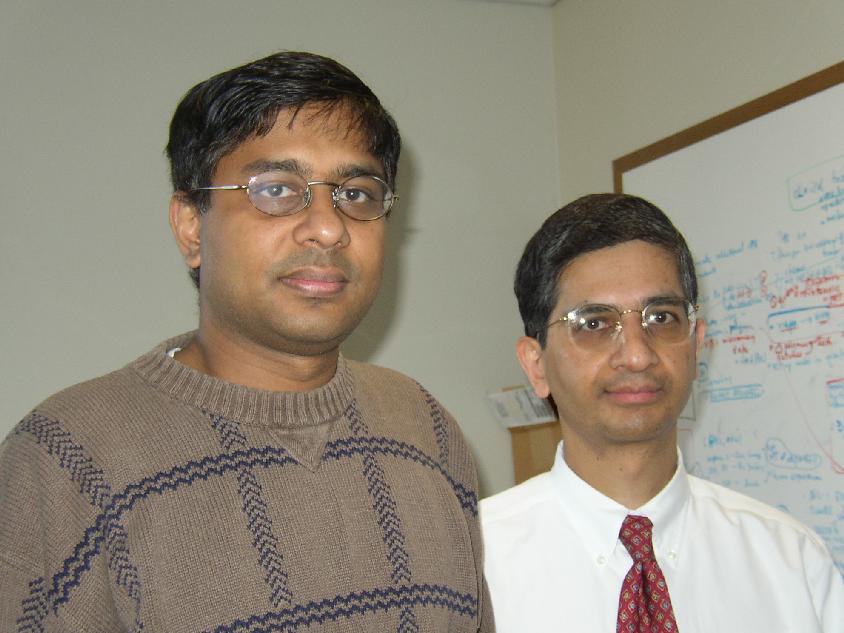Contribute
| Lokvani Talks To Dr. Vikas Sukhatme |
Chitra Parayath
04/07/2004
More than half the world's greatest discoveries have been made through serendipity--the finding of one thing while looking for something else.
Author Melvin Saunders
Talking to Dr. Vikas Sukhatme, one is transfixed by his obvious passion for his vocation. Whether he is explaining the effect of angiogenesis inhibitors on the blood vessels (to this interviewer, who gave up Biology after 8th grade) or waxing eloquent about the life of a medical researcher and a clinical physician, he is a captivating interviewee.
Sukhatme’s enthusiasm for his work goes beyond his hands-on research, which includes ground-breaking and news-making findings in treating preeclampsia. He speaks with just as much excitement when he discusses teaching or treating patients.
How did Sukhatme a PhD in Physics from MIT become a top medical researcher and practitioner at Beth Israel Deaconess Medical Center (BIDMC)? Physics can only satiate a curious mind so much, he implied, whereas the field of bio medical technology retains tremendous potential for original research and development. Medicine, he said, gave him an opportunity to unravel mysteries. He was also intrigued by the fact that medical research relies heavily on knowledge of genetics and genetic variation. After training at the Harvard Medical School, Sukhatme went on to work at Stanford University before coming back to bay area (East) and joining BIDMC and Harvard, where he is now professor of medicine.
Even though the recent Boston Globe story about the work done by Sukhatme and team on preeclampsia is what brought much fame and curiosity about this researcher and his work, he has been credited with groundbreaking research before.
Sukhatme had been testing endostatin and had found that it halted or shrank kidney tumors in mice. Endostatin belongs to a category of drugs, angiogenesis inhibitors, that selectively attack new blood vessels that grow around and into tumors and are necessary for the cancers to spread. In mouse experiments, endostatin has dramatically shrunk mouse tumors into invisibility and has done so without toxic effects.
Sukhtame smiles patiently and begins to explain what it could mean to pregnant women fighting preeclampsia. Preeclampsia is a condition that typically starts after the 20th week of pregnancy and is related to increased blood pressure and protein in the mother's urine (as a result of kidney problems). Preeclampsia affects the placenta, and it can affect the mother's kidney, liver, and brain. When preeclampsia causes seizures, the condition is known as eclampsia – the second leading cause of maternal death in the U.S. Preeclampsia is also a leading cause of fetal complications, which include low birth weight, premature birth, and stillbirth.
Some 200,000 American women, during pregnancy, suffer from preeclampsia when blood vessels to the placenta become narrowed impeding the flow of blood and oxygen to the fetus. The traditional treatment involves medication to control high blood pressure but often the baby has to be delivered early for the mother and child to survive.
Sukhatme introduces us to his team. In 2001, Dr. Ananth Karumanchi who worked with Dr. Sukhatme at BIMDC along with Dr. Sharon Maynard, undertook extensive scientific research on preeclampsia.
When Karumanchi compared the discarded placentas of women with preeclamspsia with those of healthy women using new gene chip technology he was able to isolate hundreds of genes, which was narrowed to about 20. An active gene sFLt1 (tyrosine kinase ) caught the eye of the researchers.
sFLt1 protein is released by the mothers placenta and it triggers the symptoms of preeclampsia when it binds to and gathers another group of proteins - placental growth factor and vascular endothelial growth factor. These promote the growth of small blood vessels.
Sukhtame, an expert on antiangiogenesis drugs which inhibit the growth of blood vessels and which has been used to support the theory that a tumors growth can be halted by cutting off blood supply to the tumor, immediately drew a connection between sFLt1 and the growth factor know as vegf.
Vegf (vascular endothelial growth factor) helps small blood vessels to multiply and supply the tumor that causes cancer, whereas in preeclampsia, genes such as sFLt1 halt growth factors and stop blood vessels. Some patients with cancer, who were treated with growth inhibitors to discourage blood supply to tumors, got preeclampsia. Thus, preeclampsia seemed to be the ‘opposite’ of cancer.
This suggested that a patient with preeclampsia could be treated with drugs that promoted growth, like vegf. Karumanchi found out that when pregnant rats were induced to produce sFLt1 in excess they developed preeclampsia.
So what does this discovery mean for patients around the world with preeclampsia and cancer?
Dr. Sukhatme informs us that BIDMC is working with a major drug company to develop a preeclampsia drug. The path to having a drug tested on animals, then humans and getting it approved by the FDA is a long one but Dr. Sukhatme and Dr. Karumanch are willing to wait to see the first patient getting the drug.
Said Dr. Sangeeta Bhatia, an Associate Professor of Bioengineering and Medicine at the University of California at San Diego.
“Dr. Sukhatme and his coworkers combined good experiments (testing the genes expressed in women with preeclampsia) with serendipity that reminds me of the phrase 'chance favors the prepared mind'. An intellectual connection between the studies they performed on preeclampsia and the side effects of cancer therapy led to their important findings. This is the best example of a 'light bulb' moment I've seen in recent memory, and I recently shared it with the graduate students in my laboratory as an example of good science in action. The identification of molecules involved with preeclampsia- a previously baffling syndrome- could lead to early prediction of this disease and possibly drug therapies that protect the mom and fetus.”
You may also access this article through our web-site http://www.lokvani.com/

Dr. Karumanchi and Dr. Sukhatme